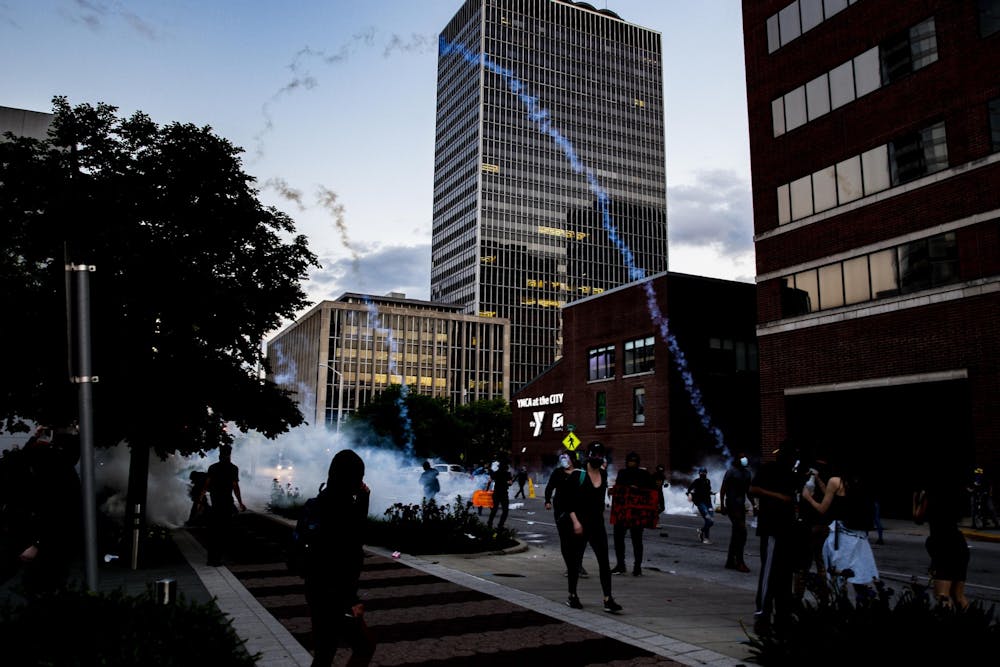In recent weeks, at least 100 law enforcement agencies around the U.S. deployed tear gas to disperse largely peaceful protests against police brutality, which occurred in the wake of many high-profile police killings of Black Americans. One such agency was the Indianapolis Metropolitan Police Department. The American Civil Liberties Union of Indiana is suing Indianapolis for IMPD’s use of tear gas, specifically regarding May 29 - 31.
According to the ACLU of Indiana’s official statement, the lawsuit was filed on behalf of Indianapolis's Black Lives Matter chapter as well as individual protesters, and it seeks a court order barring the use of chemical agents and projectiles against protesters. The statement specifically mentions tear gas and pepper pellets. This kind of legal action is badly needed everywhere that tear gas is used.
The protests in Indianapolis were largely peaceful. The police fired tear gas with no warning into a crowd that was angry, perhaps uncivil, but not violent. The ACLU characterized the IMPD’s actions as “violent and unwarranted” and taken “against peaceful protesters who were not engaged in any unlawful activity.”
It is unclear what provoked the sudden deployment of tear gas. Physical escalation — namely, breaking glass — did not occur until after police deployed tear gas. As in many other cities, escalation occurred in response to police violence, rather than as a provocation of it.
Police in Lafayette, Indiana and in Fort Wayne, Indiana also deployed tear gas May 31. Balin Brake, a Fort Wayne protester, lost his eye to a tear gas canister after dispersal orders were given, reminding us that not only the gas but also its vehicles are dangerous.
As in the Fort Wayne case, dispersal orders and curfews around the country often serve as a way to criminalize otherwise lawful activity. They make violent police actions, including the use of tear gas, suddenly and arbitrarily legal, even if those same violent actions were illegal just moments earlier.
The book “Tear Gas” by Anna Feigenbaum is the first and only comprehensive history of tear gas. Tear gas causes tearing, gagging and burning by design, but as Feigenbaum shows through her meticulous historical account, it has also caused countless miscarriages, loss of eyes and limbs, other permanent injuries and deaths.
There is no legal obligation to report tear gas-related deaths and injuries, which is part of why such a damaging chemical weapon maintains the label “non-lethal” or “less lethal” and why the aforementioned damage remains literally countless. There is also no legal obligation to report the deployment, export, purchase or environmental damage of tear gas.
Furthermore, the misuse of tear gas, such as firing it into enclosed spaces or at faces, is often done to intensify repression. Do not assume that improper deployment is accidental. Perhaps more importantly, do not assume that proper deployment is harmless. And always assume that tear gas is worse than you think.
We should not tolerate any form of atmospheric policing. We should not accept the premise that tear gas is “non-lethal” or “less lethal” when no data leading to such a conclusion exists. In fact, the data that has been scraped together by nongovernmental researchers and advocates leads to the opposite conclusion.
More actions like the ACLU lawsuit against Indianapolis should be taken nationwide. Tear gas is illegal for battlefield use, yet it is used in our streets indiscriminately — meaning too often, too liberally and with no regard for bystanders or those particularly at risk to tear gas’s adverse effects, such as children and people with respiratory conditions.
Given all of this, the question is not whether the police should be sued over tear gas use. The question is why more suits are not already underway and why we allow the police to use tear gas in the first place.
This is not just true in the U.S. It was true in Greece in 2008 and in Hong Kong in 2019. It is true in Chile, where over 200 people have suffered severe eye trauma and lost eyes to tear gas canisters and rubber bullets since the beginning of a protest movement last fall. Tear gas has been used constantly and unpredictably against Palestinians for years, as it was used against colonized peoples who wanted freedom throughout the 20th century.
As in so many political struggles, we should look to domestic and international history and news for guidance and solidarity. Some similar actions, such as a class action lawsuit out of Richmond, Virginia, and an individual lawsuit out of Columbia, South Carolina, are being taken. More victims should follow suit, and we should not rest until tear gas is out of American streets for good.
Kaitlyn Radde (she/her) is a junior studying political science.






